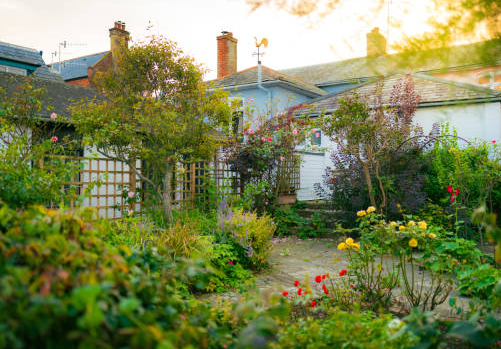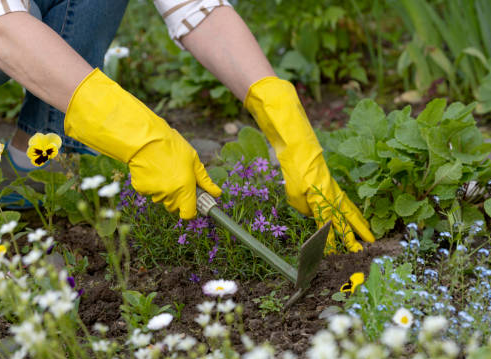Diatomaceous Earth (DE) is a natural, organic substance made from the fossilized remains of aquatic organisms (diatoms). While it’s commonly used as a mild abrasive in skincare products and toothpaste, you can also use DE in your garden to fight pests, improve soil, and more. Whether you have a large backyard or just a few potted plants on a balcony, these 7 simple methods will help your plants stay healthier.
What is Diatomaceous Earth?
Diatomaceous Earth looks and feels like talcum powder, but it’s made of the sharp, microscopic skeletons of diatoms. These microscopic skeletons are deadly to small insects. When insects come into direct contact with DE, it punctures their exoskeletons, causing them to dehydrate and die within hours. Unlike many chemical insecticides, insects do not develop resistance to DE, and it can be used to combat a wide range of common garden pests, including:
-
Ants
-
Mites
-
Earwigs
-
Flea beetles
-
Cockroaches
-
Thrips
-
Slugs and snails

How to Use Diatomaceous Earth in the Garden
Diatomaceous Earth works best when combined with other organic gardening practices, such as companion planting and soil improvement with compost. However, if you’re looking for a chemical-free way to improve your garden and keep pests at bay, using DE strategically can be a helpful addition to your pest control plan.
1. Pest Barrier
One of the best ways to use DE is to create a continuous barrier of powder around individual plants or the outside perimeter of garden beds to prevent pests from entering. This method is commonly used to stop slugs and snails from getting into vegetable beds, but you can also sprinkle DE around potted plants or on windowsills to keep ants out. For a more effective barrier, apply DE in a strip about 1 inch deep and 3 inches wide.
2. Dry Dousing
DE powder can be directly applied to plants to treat active infestations of pests like thrips, spider mites, and others. However, it’s best to avoid using it on flowering plants due to potential harm to pollinators. Many gardeners apply DE by hand, but using a DE sprayer can make the application easier. Apply a light dusting of DE directly to the infested plant and reapply as needed until the pests are eradicated.
3. Wet Dousing
If you need to apply DE to hard-to-reach areas, such as the undersides of leaves, you can mix it with water. Wet DE can be sprayed onto plants using a spray bottle or garden sprayer, and once it dries on the plant, it will begin working as an insecticide. To make your own DE mixture, combine ½ gallon of water with 1 cup of DE powder.

4. Rodent Repellent
Essential oils like peppermint, citronella, and cinnamon are commonly used as natural rodent repellents to drive away mice and other rodents. You can mix a few drops of these essential oils with 1 cup of diatomaceous earth and sprinkle the mixture in outdoor areas where rodents are active to create a homemade rodent repellent. DE’s absorbent properties help bind the essential oils, making them easier to apply. However, this method isn’t suitable for areas where pets are present.
5. Soil Pests
Invasive soil pests, like root-feeding fleas, have caused quite a stir in the gardening community, and there’s currently no approved pesticide for them. However, some studies suggest that mixing biochar and diatomaceous earth into infested soil could help control flea beetles. Unfortunately, DE can also affect beneficial earthworms, so if you want to try this method, be sure to use DE selectively.
6. Deodorizer
Thanks to its high absorbency, DE can also be used to neutralize odors in garden footwear or in other areas with unpleasant smells, like potting sheds. Simply poke a few holes in the side of a small paper bag, sprinkle some DE powder inside, and place the bag near the smelly area.
7. Soil Amendment
Sometimes, diatomaceous earth is used to improve soil structure by enhancing drainage and aeration, reducing soil compaction, and improving the condition of clay and waterlogged soils. However, compost can also be used for this purpose and is more affordable, plus it’s better for earthworms. If you want to use DE as a soil amendment, mix it with compost to make it even more effective in your garden.
Diatomaceous Earth Usage Tips
Diatomaceous Earth is relatively easy to use, but these tips will help you get the most out of it while ensuring safe and effective application.
-
Use food-grade DE only. Pool-grade DE or crystalline silica is unsafe for gardening and can be dangerous if inhaled. Always check the label to ensure you’re using food-grade DE.
-
Don’t apply to flowers. DE is a low-toxicity pesticide, but it can still harm pollinators that come into direct contact with it. To protect pollinators, only use it in a targeted manner and avoid applying it around flowering plants that attract bees and butterflies.
-
Use it at night. For the safety of pollinators, it’s best to apply DE in the evening when bees and butterflies are less active. Avoid applying DE on windy days.
-
Wear proper safety gear. DE can irritate the lungs and skin, so avoid using it around children and pets. Be sure to wear a mask, gloves, and goggles to protect yourself.
-
Reapply after rain. DE is only effective when dry, and it can be washed away in rain. Reapply after heavy rainfall to maintain its effectiveness.
-
Use sparingly. Applying too much DE can block sunlight and make it difficult for plants to photosynthesize. It’s best to apply DE in a light, thin layer.
-
Be persistent. DE kills most garden pests, but it’s not as effective against insect eggs. To deal with newly hatched pests, reapply DE to the affected plants a week or two after the initial treatment.
By following these tips, you can safely and effectively use Diatomaceous Earth to improve your garden’s health, keep pests at bay, and create a healthier growing environment for your plants. Happy gardening!

